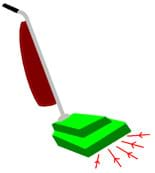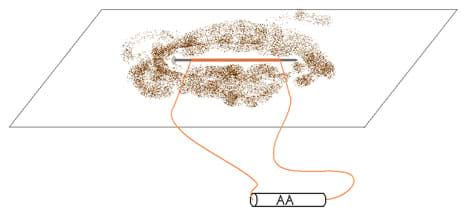Quick Look
Grade Level: 6 (5-7)
Time Required: 1 hour
Expendable Cost/Group: US $5.00 This activity also requires some non-expendable items; see the Materials List for details.
Group Size: 3
Activity Dependency: None
Subject Areas: Physics, Science and Technology
NGSS Performance Expectations:

| MS-PS2-5 |

Summary
Student teams each use a bar magnet, sheet of paper and iron shavings to reveal the field lines as they travel around a magnet. They repeat the activity with an electromagnet made by wrapping thin wire around a nail and connecting either wire end to a battery. They see that the current flowing through a wire produces a magnetic field around the wire and that this magnetic field induced by electricity is no different than that produced by a bar magnet. The experience helps to solidify the idea that electricity and magnetism are deeply interrelated.Engineering Connection
The subject of electricity and magnetism has long been a topic of interest for physicists and engineers throughout history. Great minds such as Faraday, Gauss and Maxwell made discoveries that helped shape the current world in which we live. For example, electricity and magnetism affect every modern industry whether it is communication, entertainment, medicine, warfare, manufacturing, etc. This activity is related to Faraday's law of electromagnetic rotation, which is directly linked to the electric motor. From an engineering standpoint, electric motors are vital components to many home appliances. The outcome of the experiment explored in this activity has been used by countless engineers in making our world better.
Learning Objectives
After this activity, students should be able to;
- Describe current.
- Explain how voltage produces a current.
- Explain how current produces a magnetic field.
- Describe the interconnection of electricity and magnetism.
- Identify how magnetic field lines are generated in relation to a coil of wire that has a current.
Educational Standards
Each TeachEngineering lesson or activity is correlated to one or more K-12 science,
technology, engineering or math (STEM) educational standards.
All 100,000+ K-12 STEM standards covered in TeachEngineering are collected, maintained and packaged by the Achievement Standards Network (ASN),
a project of D2L (www.achievementstandards.org).
In the ASN, standards are hierarchically structured: first by source; e.g., by state; within source by type; e.g., science or mathematics;
within type by subtype, then by grade, etc.
Each TeachEngineering lesson or activity is correlated to one or more K-12 science, technology, engineering or math (STEM) educational standards.
All 100,000+ K-12 STEM standards covered in TeachEngineering are collected, maintained and packaged by the Achievement Standards Network (ASN), a project of D2L (www.achievementstandards.org).
In the ASN, standards are hierarchically structured: first by source; e.g., by state; within source by type; e.g., science or mathematics; within type by subtype, then by grade, etc.
NGSS: Next Generation Science Standards - Science
| NGSS Performance Expectation | ||
|---|---|---|
|
MS-PS2-5. Conduct an investigation and evaluate the experimental design to provide evidence that fields exist between objects exerting forces on each other even though the objects are not in contact. (Grades 6 - 8) Do you agree with this alignment? |
||
| Click to view other curriculum aligned to this Performance Expectation | ||
| This activity focuses on the following Three Dimensional Learning aspects of NGSS: | ||
| Science & Engineering Practices | Disciplinary Core Ideas | Crosscutting Concepts |
| Conduct an investigation and evaluate the experimental design to produce data to serve as the basis for evidence that can meet the goals of the investigation. Alignment agreement: Analyze and interpret data to determine similarities and differences in findings.Alignment agreement: | Forces that act at a distance (electric, magnetic, and gravitational) can be explained by fields that extend through space and can be mapped by their effect on a test object (a charged object, or a ball, respectively). Alignment agreement: | Cause and effect relationships may be used to predict phenomena in natural or designed systems. Alignment agreement: |
International Technology and Engineering Educators Association - Technology
-
Students will develop an understanding of the relationships among technologies and the connections between technology and other fields of study.
(Grades
K -
12)
More Details
Do you agree with this alignment?
Materials List
Each group needs:
- 1 bar magnet (rectangular)
- 1 sheet of paper
- 1 3/16-in iron nail (3-in long)
- 2 meters of 28 to 32 gauge copper magnet wire (bulkwire.com)
- 100 g of iron filings
- 1 battery (AA, AAA or 9V)
- 1 pair of wire strippers
- Fields Lines Worksheet one per student
Worksheets and Attachments
Visit [www.teachengineering.org/activities/view/usf_maxwell_lesson01_activity1] to print or download.Introduction/Motivation

You will easily accept that if you push an object, if it is free to do so, it will move. You are able to see how the object moves. However, forces (or pushes and pulls) exist that are not as easily seen. The most pertinent example in our lives is gravity. We know it exists because we do not float away from the Earth, and everything falls down. However, understanding how this force acts on us can be difficult since it is far less visible or tactile than pushing on an object.
Magnets are much the same way. From observation, we know two magnets exert a force on each other. However, we cannot see contact between the magnets when they start pulling on each other. Therefore, we use field lines.
Field lines are a visual representation of force. They show the path an object would be pushed or pulled when acted upon. For a vacuum cleaner, the field lines would be pointing into the bottom where the air is pulled in (see Figure 1). For the Earth's gravity, all the field lines would be pointing towards the center of the Earth. On a magnet, the field lines point from the north pole to the south pole. This is the direction another magnet would be pulled if brought close to it.
For electromagnets, field lines are convenient. When iron shavings are poured around a magnet, they line up with the force field lines around it. This gives us a great visual representation of the invisible force of magnets. At the same time, when iron shavings are sprinkled around an electromagnet, it gives us a great visualization showing the similarities and differences between magnets and electromagnets.
Procedure
Background Information for the Teacher
The relation between magnetism and electricity is one of the key concepts in science. Knowledge of this connection led to the ability to generate electricity for our homes, the operation of moveable parts in almost every electrical device, the ability to communicate wirelessly, the ability to perform noninvasive medical procedures, the ability to see electrical signals become images on our TVs, and so much more.
The key concept that students should take away from the activity is that a magnetic field created by running a current through a wire is the same as a magnetic field created by a magnet. At the same time, students learn that an electromagnet can be turned on and off, unlike a standard magnet. From this concept, students can then understand how so many other devices around them function.
Before the Activity
- Gather materials and make copies of the Field Lines Worksheet.
- If time for the activity is limited, make the electromagnets in advance (steps 7 through 9).
- Divide the class into teams of two to four students each, and lead them through the steps below.
With the Students
- Place a bar magnet on a flat surface, such as a desktop.
- Place a piece of paper over the bar magnet so that it is completely covered and near the center of the paper.
- Sprinkle iron filings onto the paper around the bar magnet. Avoid dropping large clumps in a single spot.
- Gently shake the paper until field lines are easily seen.
- On your worksheet, sketch a picture showing how the shavings line up around the magnet.
- Carefully lift the paper and remove the magnet; then place the paper (with iron filings still on it) back on the flat surface. TIP: Attempt to not let any filings touch the magnet. Once fillings touch the magnet, it can be very difficult to remove them.
- Wrap the copper wire around the nail, leaving 4 inches of free wire at either end. Try to keep the windings tight and close together.
- Place one of the copper wires between the blades of the wire strippers. Gently pull the wire out. If done properly, you should see specks of golden brown on the scissors blades. This is the wire coating.
- Repeat step 8 with the other end of the wire.
- Place the nail in the center of the iron filings.
- Gently shake the paper.
- Sketch the pattern made by the filings at this point.

- Place either end of the wire on either contact of the battery, and then gently shake the paper (see Figure 2).
- Sketch the pattern made by the shavings. Note that the magnetic field pattern, that you have just demonstrated through your experiment, is important in designing and creating everyday engineering products such as electric motors and electric generators.
- Conclude with the post-activity assessment described in the Assessment section, and having students complete the worksheet questions.
Vocabulary/Definitions
current: A flow of electric charge. Current can also be described as the rate of flow of electric charges. In most cases, current is associated with the flow of electrons.
electricity: Any phenomena that can be associated with the presence or flow of electric charges.
electromagnet: A type of magnet in which the magnetic field is produced by the flow of current. A temporary magnet created by running a current through a coil of wire that is wrapped in a loop; usually this loop is wound around a piece of metal such as iron or iron compound.
field lines: Imaginary lines used to show direction of force. While most often used in magnetism, they are also used to illustrate electricity and gravity.
magnetic: Relating to or caused by magnetism; having the properties of a magnet, that is, of attracting iron or steel.
magnetism: The energy and forces associated with magnetically charged particles, such as those found in bar magnets; due to the Earth having a magnetic field that consistently points in the same direction, magnets have for a long time been used in navigation; magnetism is due to the movement of electrically charged particles, such as electrons.
voltage: Common name for electric potential difference. It is the driving force for electric current traveling from a point A to B; expressed in volts.
Assessment
Activity Embedded Assessment
Worksheet: During the experiment, have students draw their observations of field lines on the Field Lines Worksheet, and then answer the worksheet questions. Review their answers to gauge their mastery of the subject.
Post-Activity Assessment
Understanding of Electromagnets: To assess what students have learned, ask them to identify at least one similarity and one difference between a magnet and an electromagnet. (Possible answers: Similarities—they both act on iron, they pull on each other, they both have lines oriented from one end to the other, they both have a north pole and a south pole [or oppositely charged ends]. Differences—electromagnets use electricity while normal magnets do not, normal magnets are permanent while electromagnets can be turned on and off. Possible incorrect answers: One is stronger than the other. This property is based upon how the magnet and electromagnet are shaped, made, and what material they are made of, which can be seen in the associated activity, The Good, the Bad and the Electromagnet.)
Subscribe
Get the inside scoop on all things TeachEngineering such as new site features, curriculum updates, video releases, and more by signing up for our newsletter!More Curriculum Like This

Students are briefly introduced to Maxwell's equations and their significance to phenomena associated with electricity and magnetism. Basic concepts such as current, electricity and field lines are covered and reinforced. Through multiple topics and activities, students see how electricity and magne...

Students learn more about magnetism, and how magnetism and electricity are related in electromagnets. They learn the fundamentals about how simple electric motors and electromagnets work. Students also learn about hybrid gasoline-electric cars and their advantages over conventional gasoline-only-pow...

Students induce EMF in a coil of wire using magnetic fields. Students review the cross product with respect to magnetic force and introduce magnetic flux, Faraday's law of Induction, Lenz's law, eddy currents, motional EMF and Induced EMF.

Students investigate the properties of magnets and how engineers use magnets in technology. Specifically, students learn about magnetic memory storage, which is the reading and writing of data information using magnets, such as in computer hard drives, zip disks and flash drives.
Copyright
© 2013 by Regents of the University of Colorado; original © 2011 College of Engineering, University of South FloridaContributors
Mandek Richardson and James Cooper (under the advisement of Patricio Rocha, Dayna Martinez and Tapas K. Das)Supporting Program
STARS GK-12 Program, College of Engineering, University of South FloridaAcknowledgements
This curriculum was developed by the USF Students, Teachers and Resources in Sciences (STARS) Program under National Science Foundation grant numbers DGE 0139348 and DGE 0638709. However, these contents do not necessarily represent the policies of the NSF, and you should not assume endorsement by the federal government.
Last modified: March 6, 2022









User Comments & Tips